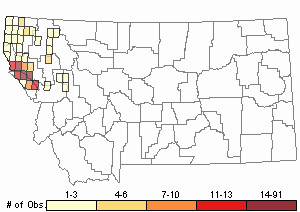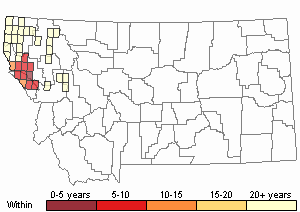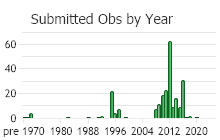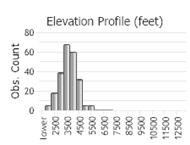View in other NatureServe Network Field Guides
NatureServe
Montana
Utah
Wyoming
Idaho
Wisconsin
British Columbia
South Carolina
Yukon
California
New York
Hillside Rein Orchid - Piperia elegans
Other Names:
Habenaria elegans
Native Species
Global Rank:
G4
State Rank:
S4
(see State Rank Reason below)
C-value:
5
Agency Status
USFWS:
USFS:
BLM:
External Links
State Rank Reason (see State Rank above)
Piperia elegans has been documented in northwest Montana since 1902 with the vast majority of observations occurring since 2008. Populations appear to be relatively common, typically composed of at least 30 plants though large populations have 200 to 500 plants. Plants have been found to be tolerant of some disturbances, such as from grazing and logging.
- Details on Status Ranking and Review
Population Size
ScoreF - 10,000 - 100,000 individuals
Range Extent
ScoreE - 5,000-20,000 sq km (~2,000-8,000 sq mi)
Area of Occupancy
ScoreE - 26-125 4-km2 grid cells
Number of Populations
ScoreD - 81 - 300
Number of Occurrences or Percent Area with Good Viability / Ecological Integrity
ScoreF - Very many (>125) occurrences with excellent or good viability or ecological integrity
Environmental Specificity
ScoreB - Narrow. Specialist or community with key requirements common
Long-term Trend
ScoreU - Unknown
Trends
ScoreU - Unknown
Threats
ScoreD - Low
CommentNo known threats. Found in an old burn, reported ungrazed in area with livestock grazing, growing with Canada thistle, often growing on logging roads.
Intrinsic Vulnerability
ScoreA - Highly vulnerable
General Description
PLANTS: Perennial herbaceous stems that grow 25-70 cm tall. Stems are single, 2-12 mm in diameter (measured above basal leaves). Roots are tubers, 15-45 mm in length, with several fibrous rootlets. Sources: Douglas et al. 2001; Lesica et al. 2012; and Ackerman and Morgan in Flora of North America (FNA) 2002.
LEAVES: 2-4 basal leaves are sessile, prostrate, and ephemeral; their leaf shape is oblong, 7–20 cm in length, and 1-7.5 cm in width. Cauline leaves are bract-like (Douglas et al. 2001), mostly 12-37 in number, but as few as 4. Sources: Douglas et al. 2001; Lesica et al. 2012; and Ackerman and Morgan in FNA 2002.
INFLORESCENCE: An often crowded, spike-like raceme, 9–30 cm in length. Flowers have white petals and green sepals. Bracts are 5–8 mm in length. Sources: Douglas et al. 2001; Lesica et al. 2012.
Phenology
Flowers June-September (Hitchcock et al. 1969).
Diagnostic Characteristics
Hillside Rein Orchid -
Piperia elegans*Inflorescence: Flowers are crowded. Flowers do not spiral on the stalk.
*Flowers: Petals are white with green sepals.
*Lip petal: Has a long, slender spur, weakly curved spur, 8-12 mm long. The spur is more than twice as long as the lip petal.
*Leaves: Prostrate, but not appressed to the ground. Often withering by the time pollination occurs.
Dense Flower Rein Orchid -
Piperia elongata, SOC
*Inflorescence: Flowers are sparse to dense, tending to overlap yet not be crowded. Flowers do not spiral on the stalk.
*Flowers: Petals and sepals are yellow-green to green.
*Lip petal: Has a long, slender spur, weakly curved spur, 6-15 mm long. The spur is more than twice as long as the lip petal.
*Leaves: Prostrate, but not appressed to the ground. Often withering by the time pollination occurs.
Alaska Rein Orchid -
Piperia unalascensis*Inflorescence: Flowers are well-separated. Flowers do not spiral on the stalk.
*Flowers: Petals and sepals are yellow-greenish.
*Lip petal: Has a short spur, clavate (club-shaped), 3-5 mm long. The spur is about as long as the lip petal.
*Leaves: Prostrate, but not appressed to the ground. Often withering by the time pollination occurs.
Bog Orchids -
Platanthera species
*Flowers: Arranged in a spike-like raceme, but do not spiral around the stalk.
*Lip petal: Forms a downward pointing spur.
*Leaves: Either near the plant's base (basal) or leafy along entire stem (cauline). If basal than either appressed to the ground or only on the lower stem (lacking upper stem leaves). If cauline then leaves are sheathing, alternately-arranged, and may whither by the time pollination occurs.
Ladies'-tresses -
Spiranthes species
*Flowers: Arranged in a spike and spiral on the stalk to form 3- or 4- ranks/columns.
*Lip petal: Lacks a spur.
*Leaves: Relatively long and narrow. Largest at the base, becoming progressively smaller towards the inflorescence. Leaves usually do not whither by the time pollination occurs.
Species Range
Montana Range
Range Descriptions

 Native
Native
Range Comments
BC to CA, ID and MT. In Montana, known from Flathead, Lake, and Lincoln Counties (Lesica et al. 2012. Manual of Montana Vascular Plants. BRIT Press. Fort Worth, TX)
Observations in Montana Natural Heritage Program Database
Number of Observations: 247
(Click on the following maps and charts to see full sized version)
Map Help and Descriptions
Relative Density

Recency



 (Observations spanning multiple months or years are excluded from time charts)
(Observations spanning multiple months or years are excluded from time charts)
Habitat
Drier, coniferous forest; valleys, montane (Lesica 2012), dry or briefly moist meadows and ditches in lowlands (Douglas et al. 2001).
(Lesica’s contribution from
Lesica et al. 2012. Manual of Montana Vascular Plants. BRIT Press. Fort Worth, TX)
Reproductive Characteristics
Flowers: Pleasantly musky, heavily scented at night (FNA 2002); sepals 4–5 mm in length (Lesica 2012), white with a green central nerve; the 2 lateral sepals widespreading, nearly lanceoloate to ovate-elliptic, a little longer than the upper sepal (FNA 2002); upper sepal mostly erect; petals white to light green, lanceolate (Douglas et al. 2001), 3-6 mm in length; lip petal white to light green, deltoid-lanceolate to lanceolate (FNA 2002), 3–5 mm in length; spur weakly curved, 8–12 mm in length (Lesica 2012).
Fruit: Capsule ascending to upright (Douglas et al. 2001), 6–8 mm in length (Lesica 2012); seeds brown (FNA 2002).
(Lesica’s contribution adapted from
Lesica et al. 2012. Manual of Montana Vascular Plants. BRIT Press. Fort Worth, TX)
Stewardship Responsibility
References
- Literature Cited AboveLegend:
 View Online Publication
View Online Publication Douglas, G.W., D. Meidinger, and J. Pojar, editors. 2001. The Illustrated Flora of British Columbia. Volume 7. Monocotyledons (Orchidaceae through Zosteraceae). British Columbia Ministry of Environment, Lands and Parks and British Columbia Ministry of Forests, Victoria. iv + 379 pp.
Douglas, G.W., D. Meidinger, and J. Pojar, editors. 2001. The Illustrated Flora of British Columbia. Volume 7. Monocotyledons (Orchidaceae through Zosteraceae). British Columbia Ministry of Environment, Lands and Parks and British Columbia Ministry of Forests, Victoria. iv + 379 pp. Flora of North America Editorial Committee. 2002. Flora of North America North of Mexico. Vol. 26. Magnoliophyta: Liliidae: Liliales and Orchidales. New York, NY: Oxford Univ. Press. xxvi + 723 pp.
Flora of North America Editorial Committee. 2002. Flora of North America North of Mexico. Vol. 26. Magnoliophyta: Liliidae: Liliales and Orchidales. New York, NY: Oxford Univ. Press. xxvi + 723 pp. Hitchcock, C. L., A. Cronquist, M. Ownbey, and J. W. Thompson. 1969. Vascular Plants of the Pacific Northwest. Part I: Vascular Cryptogams, Gymnosperms and Monocotyledons. Seattle, WA: University of Washington Press. 914 pp.
Hitchcock, C. L., A. Cronquist, M. Ownbey, and J. W. Thompson. 1969. Vascular Plants of the Pacific Northwest. Part I: Vascular Cryptogams, Gymnosperms and Monocotyledons. Seattle, WA: University of Washington Press. 914 pp. Lesica, P., M.T. Lavin, and P.F. Stickney. 2012. Manual of Montana Vascular Plants. Fort Worth, TX: BRIT Press. viii + 771 p.
Lesica, P., M.T. Lavin, and P.F. Stickney. 2012. Manual of Montana Vascular Plants. Fort Worth, TX: BRIT Press. viii + 771 p.
- Additional ReferencesLegend:
 View Online Publication
View Online Publication
Do you know of a citation we're missing? Lesica, P., M.T. Lavin, and P.F. Stickney. 2022. Manual of Montana Vascular Plants, Second Edition. Fort Worth, TX: BRIT Press. viii + 779 p.
Lesica, P., M.T. Lavin, and P.F. Stickney. 2022. Manual of Montana Vascular Plants, Second Edition. Fort Worth, TX: BRIT Press. viii + 779 p. Meier, G.A. 1997. The colonization of Montana roadsides by native and exotic plants. M.Sc. Thesis. Bozeman, MT: Montana State University. 45 p.
Meier, G.A. 1997. The colonization of Montana roadsides by native and exotic plants. M.Sc. Thesis. Bozeman, MT: Montana State University. 45 p.
- Web Search Engines for Articles on "Hillside Rein Orchid"





